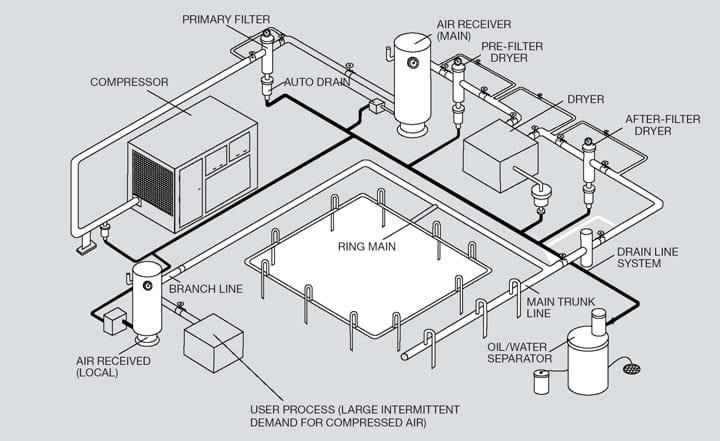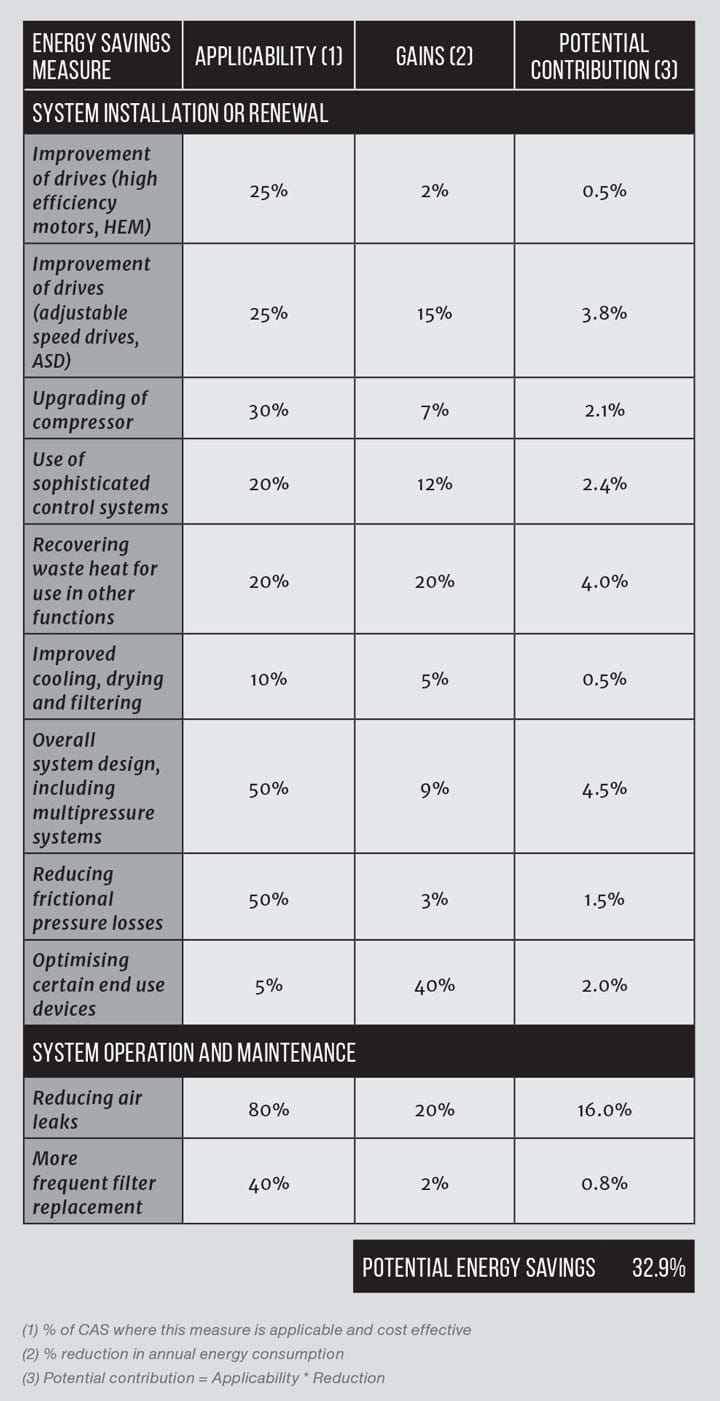Waste Not Want Not
Vanda Jones discusses how you can cut your compressed air energy consumption
IN the chemical industry, just as in many other sectors, compressed air is used extensively as a safe and versatile source of power. Often referred to as the fourth utility, we rely on its availability, sometimes 24/7, to power mission-critical processes that keep our plants performing profitability.
However, it is not a free resource. Generating compressed air can be very energy intensive, representing between 5-30% of a site’s total electricity bill.
Coupled with this significant overhead, poor practices and housekeeping can also contribute to unnecessary wastage. According to a report entitled Compressed Air Systems in the European Union, when looking at the most important energy-saving techniques available to compressed air users, the energy savings amount to 32.9%, achievable over a 15-year period.
This article will take you through some of the key factors when embarking on a compressed air energy reduction programme. I’ll outline some of the areas to consider in order to cut energy and carbon in a typical compressed air system, including highlighting areas where waste occurs and how to minimise it.
Compressed air energy in context
Let’s begin by putting this energy consumption into the context of the current political and economic landscape.
The chemicals sector is the UK’s biggest single industrial energy consumer by a significant margin. According to the Chemical Industry Association’s UK Chemical and Pharmaceutical Industry Facts and Figures report, plants use the equivalent of 3.4m t/y of oil, spending around £2bn (US$2.6bn) on fuel and electricity. As well as the financial cost, this also contributes around 18m t of CO2 to the sector’s overall emissions, with around 36% of this being electrical energy.
At the same time, carbon and climate change are hitting UK and international headlines, with movements such as Extinction Rebellion and campaigners including Greta Thunberg and David Attenborough calling for governments to act now to limit environmental damage.
Compressed air energy is often overlooked, when, as we have already learnt, the potential for wastage is substantial and represents a considerable overhead, not to mention carbon footprint that could be reduced
It comes as no surprise that operators are keen to take steps now to reduce their reliance on electrical energy. The Government’s Clean Growth Strategy for meeting the UK’s legally-binding carbon commitments aims to help businesses decarbonise. Part of the strategy includes the Industrial Decarbonisation and Energy Efficiency Roadmap Action Plan. In collaboration with the Chemistry Growth Partnership (CGP), the action plan will seek to reduce greenhouse gas emissions and become more energy efficient while remaining competitive during the UK’s low carbon transition.
With so much emphasis on carbon reduction, your business is probably already taking steps to reduce your reliance on electrical energy. Yet, compressed air energy is often overlooked, when, as we have already learnt, the potential for wastage is substantial and represents a considerable overhead, not to mention carbon footprint that could be reduced.
In 2020, BCAS is celebrating 90 years as the UK’s sole trade body for compressed air and vacuum users. Alongside our members, we will be campaigning throughout the year to make users aware of the simple steps they can take to reduce their compressed air energy consumption – asking the question, what if we could reduce this figure? Imagine the carbon savings that the industry as a whole could achieve by taking a few simple, low-cost steps to help cut its energy consumption from compressed air?

Take a system approach
A compressed air system is just that. A system, and every element of it impacts on its energy consumption. When discussing efficiency and the potential savings that could be realised, it is important to take a full, system approach – from generation to air treatment to distribution and finally, the point of use.
Identify wastage
An ideal place to start is to identify some of the key areas where valuable compressed air can be wasted by processes or people downstream of the compressor.
For example, if you install the most efficient compressor available, but connect it to a system with a 30% leak rate, then all the benefits are lost. You should aim to improve the overall system efficiency. Efficiency in the generation of compressed air is one aspect but targeting avoidable waste in the system is even more important.
Many actions will require elements of maintenance or equipment/system upgrade, but the human element should not be overlooked. You can make substantial efficiency improvements by implementing new processes and encouraging staff to use compressed air more efficiently and safely.
Table 1 highlights some typical energy saving measures, categorising these by their applicability and cost effectiveness and then providing an indication of their potential energy-saving reduction. The final column indicates which measures could then deliver the highest potential contribution.

Detect and fix leaks
We can see that reducing air leaks can have the biggest impact on overall system efficiency. Leak rates in industrial systems are typically between 20–40%, meaning the compressor has to work harder, and therefore consume more energy, to compensate for the pressure loss.
A tiny leak of just 3 mm can cost more than £700 a year in wasted energy, but an out-of-hours survey can identify leaks easily. Simply walk the site, listening for leaks.
You can then confirm the location using an ultrasonic leak detector, a leak detection spray, or even a soap solution brushed on to pipe fittings.
Once you have identified the leaks, you can then implement an improvement programme. First, tag the leaks and record on a site plan. Next, grade the priorities, fixing the largest leaks first and as soon as practicable. Finally, make monitoring a collaborative process by encouraging your staff to report leaks as soon as they are discovered.
Once you have repaired the leaks, you should check the pressure drop from the compressor to each point of use, as you may be able to reduce the generation pressure and save further energy.
Always remember to consider air leaks as part of any wider system adjustments. For example, turning down your compressor can have an impact on the performance of air treatment. Make sure to take advice from your supplier or service agent to help determine the demand placed on the compressor to supply the system and therefore its energy consumption.
Switch off
Even when off-load, compressors can consume up to 70% of their full load power, so switch off units where there is no demand for air. We suggest that you check the time switch settings regularly to ensure you are optimising running hours, as this can also help to reduce maintenance costs.
Where appropriate, install energy management systems to turn compressors off when they are not being used.
Recover heat
As much as 95% of the energy consumed by a compressor is converted to heat and, unless captured, will be wasted to the atmosphere. Many manufacturers of compressed air systems offer heat recovery systems, which can often be retrofitted. This allows you to recycle this excess heat; re-directing the hot oil to an oil-to-water heat exchanger.
This is of particular benefit in the chemical sector, where there is a high demand for process heat. The heat can be transferred to water to raise steam and to heat water, saving considerably on energy costs.
Reduce the pressure
Compressed air is often generated at around 8 bar, (800 kPa) even if the point of use only requires 6.5 bar. Speak to your service provider or manufacturer about turning down the pressure at the point of use and whether this could help save you energy.
You should also be mindful of pressure drop. This should be less than 10% of the compressor’s discharge pressure, as measured from the compressor outlet to the point of use. Thus at a pressure of 7 bar, the pressure drop should be less than 0.7 bar.
Review compressed air usage
Compressed air is energy intensive to run, and cheaper options exist for certain jobs. For example, there may be more energy-efficient alternatives for drying and ventilation. However, for applications where there are risks of explosion or electrical interference, compressed air remains the best option.
Train and involve staff
We recommend simple awareness sessions to advise staff about the costs and safe use of compressed air. For example, not allowing benches or equipment to be cleaned down with compressed air will save a significant amount of air being vented into the atmosphere. It is far safer to carry out such cleaning using a vacuum system to reduce the risk of injury.
Optimise compressed air use
If compressed air is appropriate for the job, could it be delivered more efficiently? If your air knives feature open-ended pipes, fitting a venturi-type nozzle can use 30% less compressed air. By making the operation much quieter, it will improve the working environment too.
Air distribution network: zoning
Not all parts of the network operate to the same hours or the same pressure, so separate the compressed air system into zones. At the same time isolate redundant pipework. When replacing your piping, consider all the alternatives to the usual galvanised steel. Aluminium and plastic pipes do not corrode and also have a much smoother internal finish causing less pressure drop and thus saving energy.
Don’t over treat air
Treating air to remove dirt, water and oil is necessary but can use a lot of energy. Your process is likely to only need a proportion of the compressed air to be treated to a very high purity. In these cases, excellent savings are achievable by treating all the generated air to the minimum acceptable level and improving the purity (quality) to the desired level at the usage point.
Service and maintain
Low-cost, regular maintenance will help retain low leak rates and reliability of equipment. You should also consider a policy that specifies that energy efficient options are purchased when replacing all equipment – whether it is a basic drain valve through to the actual compressor unit itself.
Finally, always specify the manufacturer’s genuine spare parts and don’t be tempted to use cheaper alternatives. They could help you realise significant savings in excess of 25%.
Conclusion
There are many reasons for wanting to reduce energy consumption from your compressed air system. The financial gains are clear to see alongside tangible environmental benefits, which will help improve your business’s bottom- line profitability, its green credentials and your customer reputation.
Compressed air systems offer many straightforward energy savings and as we have highlighted, implementing just one or two of the steps highlighted above can help you minimise avoidable waste significantly.
In doing so, it will also result in a safer, more reliable and effective source of power.
Further reading
1. BCAS’s Reducing Energy Consumption from Compressed Air Usage best practice guide, www.bcas.org.uk
2. BCAS’s The Filtration and Drying of Compressed Air best practice guide, www.bcas.org.uk
Recent Editions
Catch up on the latest news, views and jobs from The Chemical Engineer. Below are the four latest issues. View a wider selection of the archive from within the Magazine section of this site.




